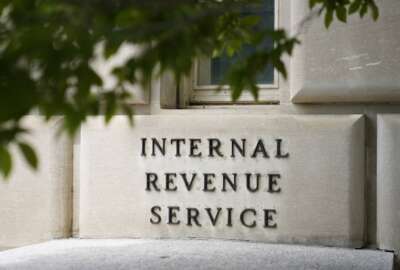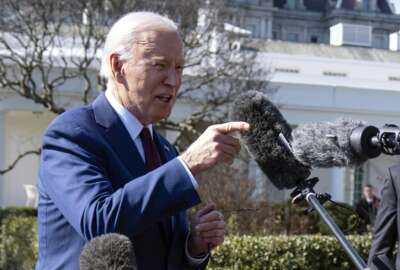Hubbard Radio Washington DC, LLC. All rights reserved. This website is not intended for users located within the European Economic Area.
IRS could tighten up plans for some of that extra ‘modernizing’ money
The Inflation Reduction Act showered billions on the IRS and the agency developed a strategic operating plan for modernizing its information technology.
The Inflation Reduction Act showered billions on the IRS and the agency developed a strategic operating plan for using some of the money for a long-held goal: Modernizing its information technology. The Government Accountability Office (GAO) found that IRS officials could do just a bit more to complete their plans. For details, the Federal Drive with Tom Temin spoke with GAO’s Director of Information Technology and Cybersecurity, Dave Hinchman.
Interview Transcript:
Tom Temin And the IRS has been on a modernization drive for 30 years, we should point out. But, you know, modernization is always out there in front of every agency. And this big dollop of money they got through the Inflation Reduction Act, what are they not doing yet that they need to do for modernization?
Dave Hinchman So there are a couple of things that we found when we did our review out of the large pool of money that IRS got, as you mentioned, as part of the Inflation Reduction Act, almost 5 billion was specifically dedicated for what IRS calls business systems modernization, which is modernizing the tax systems that directly impact you and I, that process our tax returns and make all that part of IRS work. However, when we looked at this new strategic operating plainly, you mentioned that’s really designed to carry IRS forward for the next seven years until 2031. We found that the part that directly impacts technology, which is one of their five strategic objectives, didn’t have what we call a roadmap yet. So, there was a vision for what they were going to accomplish. There were some broad, high-level goals, but none of the actionable information that really gives you a sense of whether that’s going to be done on time. They do say that that part of this roadmap is coming soon, but we haven’t seen it yet.
Tom Temin Yeah, they have five objectives, as you pointed out, which are kind of boilerplate. I mean, you know, better taxpayer service quickly resolve issues, which is taxpayer service enforcement, workforce and culture improvement. I mean, they’re kind of generic goals that any agency could apply.
Dave Hinchman Yes. And I think that the fourth one, this technology one IRS even admits is what underpins all five of the objectives, especially the other four. So, it’s really important that when they finish this missing part of this enterprise roadmap, that it really gets at what it is that they’re going to accomplish with this large pot of money over the next seven years.
Tom Temin I mean, I don’t think agencies have exhibit 53s anymore that detailed it plans. Those went away at some point along the line. But they do know, don’t they, the specific systems they need to do like the master file system.
Dave Hinchman Yes. And they have modernization plans and they’re working on those. When I last visited with you a year ago, we talked about a report we did looking at legacy IT systems, either IRS and the challenges they were encountering in modernizing the systems. So, when they developed this new strategic operating plan, they realigned a lot of those modernization efforts to better accommodate this new vision. And they have not yet done the modernization plans that accompany each of those modernization efforts. And so, this is a plan that has things like the milestones and the work that you need to do necessary, and whether there’s a legacy system that you need to dispose of afterwards. We’ve been told that those plans are in progress, but we haven’t seen them yet.
Tom Temin And without those plans in place, then can they really go about the contracting that’s needed? And that could take a couple of years to get these goals done?
Dave Hinchman Yes and no. I think for any of the smaller efforts that are maybe a little bit narrower in scope, I think the modernization plan really is an important thing. But you could also have maybe you’ve done the milestones, and you know the work necessary, but you haven’t figured out how to dispose the legacy system yet. That’s not always a bad thing, because you might have some runway, right, to figure out what you’re going to do with this old technology. Ideally, we’d love to see everything done from day one, so that we know that the agency has a good vision for where they’re going, but it’s not always necessary. But it is something that needs to be done at some point.
Tom Temin And just a quick question on that idea of disposal. I mean, it used to be that modernization was a matter of hardware replacement on regular intervals to run the same code. Now the code changes and the hardware are sort of immaterial. So, what does it mean in this day and age for disposal?
Dave Hinchman Well, there certainly is a hardware aspect. If you’re upgrading a system to a more modern technology platform, you may have old equipment that you need to get rid of. But there’s also turning off the code, right. You’ve got this new code for this new system that’s maybe coexisting. Perhaps you’re running the two systems in parallel to make sure the new one works. So, then you have to make sure that you understand how to turn off that old code and make sure that it’s not interfering with new. So, there’s yeah, it’s not it’s not throwing something out necessarily, but is making sure that the vestiges of that old system aren’t around to interfere with your work anymore.
Tom Temin And some of that old code they might want to preserve for historical purposes.
Dave Hinchman There is some dated code in there. Certainly. You and I have talked about the integrated master file, which is the listeners is the system that processes all of our individual tax returns. It’s been around since the late 60s. It was literally deployed when we were still sending rockets to the moon. So yes, it’s building COBOL, which is an ancient language not really supported by technology anymore. So yeah, there’s a little bit of our artifact in there.
Tom Temin We’re speaking with Dave Henchman, director of information technology and cyber security at the GAO. So, you have not a long list of recommendations for them. And most of them are really not so much technical, but managerial.
Dave Hinchman Yes, very program focused. We had three recommendations coming out of this. One is to ensure they complete the enterprise roadmap, which is, as we talked about, is what’s going to have the sort of the tactical execution on that fourth strategic objective that involves technology. Also, that they complete the plans for the modernization program. This will be important tools for them as they move down this journey over the next seven years. Getting towards the 2031 target date for implementing this strategic roadmap. But then also there was a third recommendation we had about how they report to Congress. IRS is currently required to produce a quarterly report to Congress on the status of their I.T. modernization. However, we’ve found historically, and we’ve talked to IRS a lot about this. They don’t do a good job of including information about baseline changes to projects. They’ve gotten better about managing that internally. But the reports to Congress, I think for oversight purposes, it would be great to include that information as well, just to help Congress better understand changes in programs over time.
Tom Temin And it’s probably a wise policy if you want to keep the appropriations coming for those projects.
Dave Hinchman You know, I think an educated appropriator is always a happy appropriator. You know, things aren’t always going to go perfectly. These are I.T projects. They’re complex. There can always be delays. But I think we’ve found over time that the more you can communicate with the appropriators to help them understand what you’re doing, that you have run into a roadblock, but that you have a plan to get over. That roadblock makes for better communication and better relationships.
Tom Temin And more detailed plans with respect to the spending patterns and timelines, and the goals and milestones of the individual projects. To get back to that contracting question. Wouldn’t that enable, I would think, better specs and better requirements building in your contracting?
Dave Hinchman Absolutely. You know, I think IRS has come a long way in how they manage their projects. I think this sort of sea change in this infusion of cash from the Inflation Reduction Act is truly made a transformative difference in how they can approach this final push. They need to get the IMF retired and replaced. And yes, and so now we see how they’re managing these projects, you know, on a daily basis, the quarterly status briefings that we have with IRS. We’ve seen a big difference in how they’re doing that. And that should be reflected also in their ability to let contracts and target the work that needs to be done.
Copyright © 2024 Federal News Network. All rights reserved. This website is not intended for users located within the European Economic Area.
Tom Temin
Tom Temin is host of the Federal Drive and has been providing insight on federal technology and management issues for more than 30 years.
Follow @tteminWFED




